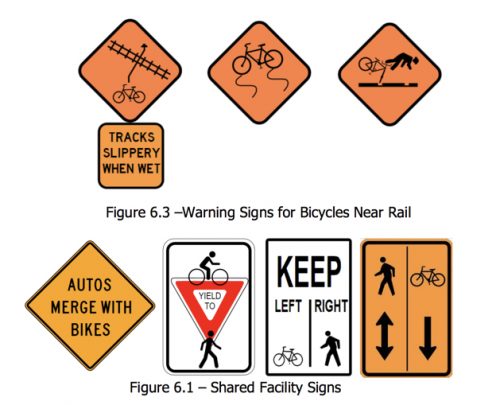
The Portland Bureau of Transportation has published its first-ever manual for temporary traffic control designs. Wonky words aside, this new guide is an important tool that could lead to safer cycling (and walking and driving) through work zones.
The guide has been endorsed by Portland’s City Traffic Engineer Lewis Wardrip and is aimed at designers, engineers, utility and maintenance workers, and even astute tactical urbanists (wink wink). Chapters include comprehensive lists of pertinent laws and city code/permitting requirements, recommended devices and products to get the job done, and how to train flaggers and traffic control measures. There are also of examples of safe work zones across a variety of roadway types and conditions — from one-way streets to bike lanes.
Section 6.6 of the guide (starts on page 50) is devoted to “Bicycle Accomodations”. The over-arching rule described in the manual is essentially “do no harm.” “When an existing bicycle lane or path is disrupted or closed,” it states, “a temporary bicycle facility should include the features and characteristics present in the existing facility.”
Here’s an excerpt from that section:
Temporary bicycle facilities may be given priority over parking and vehicle lanes on a multilane road, as determined by the Traffic Engineer. Bicycles should be separated from automobile traffic whenever possible. In situations where it is not feasible to provide an exclusive bicycle facility, bicycles should be directed to either a shared path (such as a sidewalk) before being directed to share a travel lane with automobile traffic.
The method for providing safe accommodations for cyclists should be prioritized as follows:
A. Provide a temporary bike lane on the same roadway past the work zone by shifting and narrowing the adjacent traffic lanes.
B. Provide a temporary bike lane in an existing traffic lane on multilane streets.
C. Merging cyclists and adjacent traffic into a shared travel lane (low-speed only).
D. Directing cyclists onto a shared path with pedestrians.
E. Provide a bicycle detour route.Advertisement
Minimum lane widths for bicycle and multi-use facilities are listed in the General Requirements chapter under Lane Requirements [Bicycle lanes should be maintained to four feet minimum. Multi-use pedestrian/bicycle lanes should be maintained to a minimum unobstructed width of eight feet, and a minimum vertical clearance of eight feet.]. When there is insufficient roadway width to maintain a separate bicycle and automobile lanes, mitigations should be made with relevant traffic control measures, e.g. advisory speed zone, advance warning signage, bike route detours, or auto detours. Give proper notice to bicycles, pedestrians, and vehicles regarding a change in use to a shared route.
People riding bikes will frequently ride behind a line of channelizing devices, such as cones, when they do not perceive a hazard, even if it is not safe to ride in the work space. To prevent cyclists from entering the work space, place “Bicycles KEEP LEFT (RIGHT)” signs, as shown in Figure 6.2, along the work space following access points and at regular intervals throughout a longer work zone as a reminder bicycle traffic. Caution tape may also be used to prevent bicycles from encroaching into the work space by, stretching it tightly between the tops of closely-spaced tubular markers.
And here’s the guidance for “Bike Facilities on Streets with Tracks”:
Bikes cannot be shifted onto lanes with rail tracks. When shifting or merging traffic into a lane with tracks, plan an alternate route for bikes that is smooth and free of tracks or other obstructions which may be hazardous to bicycles.
Bike routes should cross tracks at an angle between 90 and 60 degrees. Bicycles must be able to cross tracks fully upright and not leaning, thus, do not cross cyclists over tracks within a curve. When bike lanes will be transitioned across tracks, advance warning signs should be used to alert people on bikes of the hazard. Some examples of such signs are shown below.
In addition to (hopefully) encouraging work crews and engineers design better work zones, this new manual is a great addition to the advocates’ toolbox. It’s something we can use to hold PBOT accountable when sharing concerns we see on the street. You can download the manual here (PDF)
— Jonathan Maus: (503) 706-8804, @jonathan_maus on Twitter and jonathan@bikeportland.org
Never miss a story. Sign-up for the daily BP Headlines email.
BikePortland needs your support.

